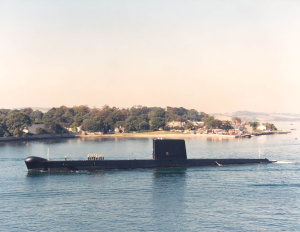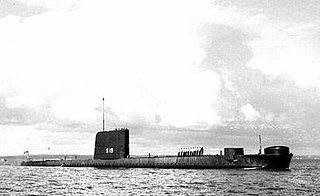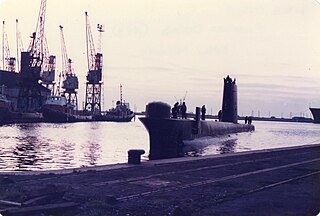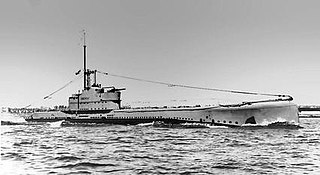
HMS Ocelot (S17) is an Oberon-class diesel-electric submarine which was operated by the Royal Navy.
HMAS Orion was an Oberon class submarine of the Royal Australian Navy (RAN). One of six submarines ordered by the RAN during the 1960s, Orion, named after the constellation in a break from ship-naming tradition, was built in Scotland and commissioned in 1977. Orion was one of two Oberon-class submarines designed for intelligence gathering and conducted regular patrols in Soviet, Indian and Chinese waters to gather information regarding enemy capabilities.

HMS Onyx was an Oberon class submarine of the Royal Navy.

HMS Onslaught was a British Oberon-class submarine operated by the Royal Navy.

HMS Oberon was the lead ship of the Oberon-class submarines, operated by the Royal Navy.

HMS Odin was a British Oberon-class submarine operated by the Royal Navy.

HMS Sealion (S07) was a Porpoise-class submarine.

HMS Opportune (S20) was an Oberon-class submarine of the Royal Navy.

HMS Otus was a Royal Navy Oberon-class submarine launched in 1962. She was decommissioned in the early 1990s and is now a naval museum in Germany.
HMS Ambush (P418/S68/S18), was an Amphion-class submarine of the Royal Navy, built by Vickers Armstrong and launched 24 September 1945.

HMAS Otway was an Oberon-class submarine of the Royal Australian Navy (RAN). One of the first four Oberon-class boats ordered for the RAN, Otway was built in Scotland during the mid-1960s, and commissioned into naval service in 1968. The submarine was decommissioned in 1994. The submarine's upper casing, fin, and stern are preserved at Holbrook, New South Wales.

HMS Olympus was an Oberon-class submarine that served in the Royal Navy, and later in the Canadian Forces as a submarine trainer.

HMS Osiris (S13) was an Oberon-class submarine that served in the Royal Navy.

HMS Opossum (S19) was an Oberon-class submarine in service with the Royal Navy from 1964 to 1993.

HMS Cachalot (S06) was a Porpoise-class submarine. Her keel was laid down on 1 August 1955 by Scotts Shipbuilding and Engineering Company at Greenock. She was launched on 11 December 1957, and commissioned on 1 September 1959.

HMS Oracle was an Oberon-class submarine of the Royal Navy.

HMS Otter (S15) was an Oberon-class submarine of the Royal Navy.

HMAS Oxley was an Oberon class submarine of the Royal Australian Navy (RAN).

HMS H32 was a H-class submarine constructed for the Royal Navy. The submarine entered service in 1919 and served in the Second World War, one of only seven of the class to do so. During Warship Week 1942 H32 was adopted by Lydney RDC (Gloucestershire). The submarine was sold for scrap in 1944.

HMS Oberon was the prototype for the Odin-class submarine of the Royal Navy.


















